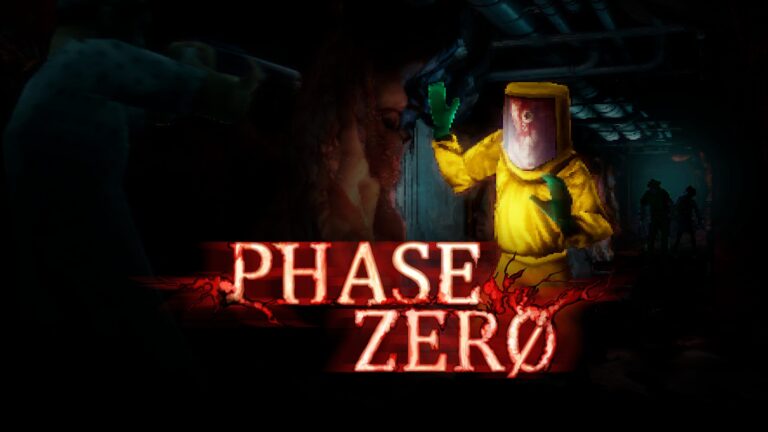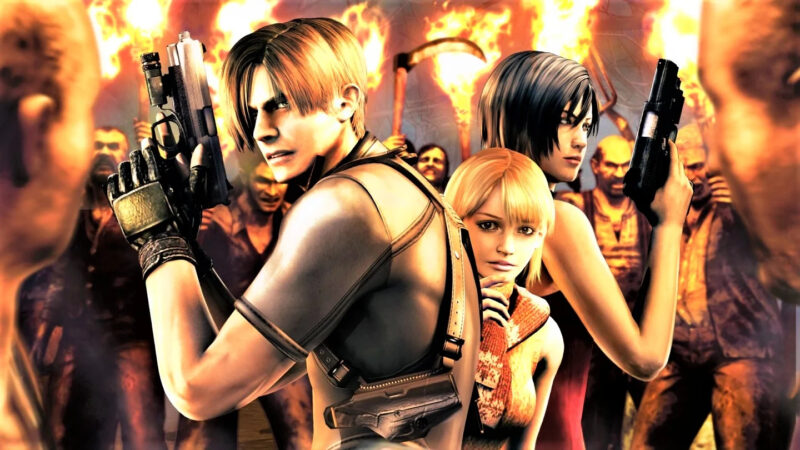 It’s that time again. As I’ve done with the first three Resident Evil titles, we’ve finally come to what’s possibly one of the most beloved (and one of the most ported) entries in the series: Resident Evil 4. The seminal 2005 classic that changed the gaming landscape and third-person shooters forever is now 17 years old, and with Resident Evil 4 Remake steadily approaching on the horizon, I figured it was time to revisit the original one last time. As before, this guide is designed to give you the basic and best tips to start your adventure with, as well as give you the full deets on the variety of versions that have been released since its original 2005 debut.
It’s that time again. As I’ve done with the first three Resident Evil titles, we’ve finally come to what’s possibly one of the most beloved (and one of the most ported) entries in the series: Resident Evil 4. The seminal 2005 classic that changed the gaming landscape and third-person shooters forever is now 17 years old, and with Resident Evil 4 Remake steadily approaching on the horizon, I figured it was time to revisit the original one last time. As before, this guide is designed to give you the basic and best tips to start your adventure with, as well as give you the full deets on the variety of versions that have been released since its original 2005 debut.
Platform
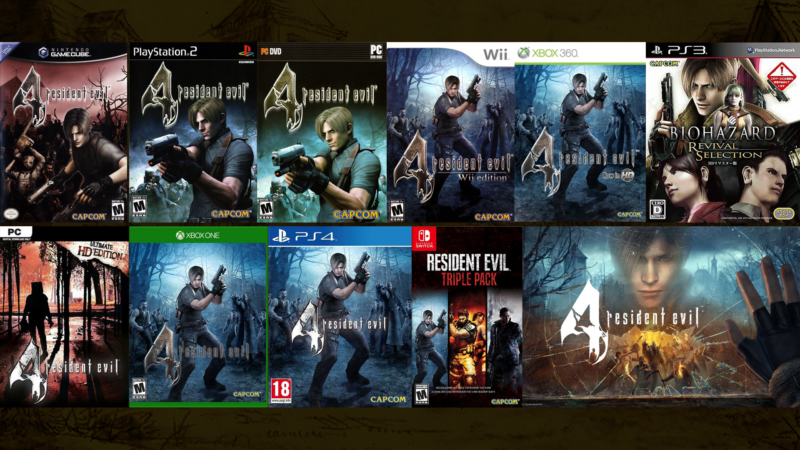
Now it seems almost comical to even try to differentiate a dozen different releases of Resident Evil 4, but I’m gonna try anyway. Unlike previous RE games, however, Resident Evil 4 offers less in the way of different content between each version and more along the lines of different specifications between each version. Note: the Zeebo/iOS version of Resident Evil 4 is not included, as it is a completely different game, acting more as a demake than a real port.
GameCube
The one that started it all, the original 2005 GameCube release is objectively the most bare-bones version, thanks to not including the Separate Ways campaign included in the PlayStation 2 release and onwards. That said, it’s visually one of GameCube’s best-looking games, and features a lot of technical differences that set it apart from other versions. The most obvious differences are things like a few tweaks surrounding damage output and some audio/visuals, and the Merchant selling infinite First Aid Sprays, which was never featured in any other version. It’s still a fantastic way to play, and I personally think the GameCube controller is one of the best to play the game with even to this day. It’s also unique in that it arrives on two discs, the first being chapters 1-4, and the second being chapters 5 and 6. The original release can be found pretty cheaply online, ranging from $15-40 used depending on the quality/Player’s Choice packaging.
PlayStation 2
Released a little under a year later (and thus ending Capcom’s “Capcom 5” deal with Nintendo) the PlayStation 2 port brought along a ton of tweaks and bonuses (including a new costume apiece for Leon and Ashley and a new unlockable weapon), not to mention the addition of the massive Separate Ways side campaign — but it also featured a tremendous amount of downgrades that make it difficult to recommend in the face of future ports. Firstly, the visuals are extremely blurry and washed out in comparison to the GameCube version, making it easily the worst-looking console version available. It also doesn’t feature real-time cutscenes, but instead pre-recorded FMVs of them (which means your choice of bonus costume won’t appear). Audio is also a bit crushed sounding, with many voices and sound effects coming across and muffled. If it’s your only option, it’s still the complete Resident Evil 4 package and hardly the worst version overall, but this one is better left to collectors rather than a way to truly experience Leon’s adventure. Much like the GameCube version, this can be found extremely cheap, ranging from $10-$25.
Sourcenext (Windows)
Easily the worst possible version of Resident Evil 4 available, the Sourcenext PC port is infamous for the incredible downgrades made following the release of the PlayStation 2 version. From shockingly terrible visuals (which removed essentially all of the lighting), bugs, and low-quality textures, the Sourcenext version is essentially little more than a curio rather than a way to truly experience this game. It’s completely abandonware at this point, so grabbing a copy is objectively free through the right means, but the question is — would you want to?
Wii Edition (Nintendo Wii/WiiU)
A few years later the massive success of Nintendo’s 7th generation console, the Wii, saw the release of yet another version of Resident Evil 4. This port, monikered as the “Wii Edition”, was the complete experience from the PS2 release, but with all of the original visuals and audio from the GameCube version reinstated. The exciting part here, however, is the inclusion of all-new (and to this day totally unique to this version) aiming controls using the Nintendo Wii’s remote controller. Rather than steering Leon’s laser point around the screen with the left stick, Wii Edition now saw your aim flick across the screen as fast as your wrist could. This resulted in a much faster, more action-heavy experience as you could now mow through enemies with higher speed and accuracy than in any version before it, turning you into a veritable Terminator as you sliced your way through the Ganado hordes. This does result in a much easier experience, but it’s also incredibly fun so hey. This version can still be found for about $10-$20 online.
‘Now in HD’/Revival Selection (Xbox 360/PlayStation 3)
A few years passed before Resident Evil 4 saw another release, but finally, 2011 saw a new and shinier version than ever. As part of a two-game release with Code: Veronica X, the Now in HD version sported new, upscaled 720p graphics (I know, hardly ‘HD’ anymore but it was buff at the time) and full Achievement/Trophy support. There were no real differences between this version and the Wii Edition release on a technical or content level, other than the obvious removal of the no longer supported motion controls. This version also integrated new leaderboards, however, they were next to useless due to cheaters who managed to get clear times often in under a second, so meh. The biggest note here is that the PlayStation 3 version weirdly retains the muffled audio from the PS2 release. This version can still be purchased digitally for $20, although there also exists a Japanese-only physical release that can be found as part of the BioHazard Revival Selection collection with Code: Veronica X Now in HD for about $30.
Ultimate HD Edition (Steam)
In 2014, Resident Evil 4 received what might be its most important port — the Ultimate HD Edition. This version featured a huge amount of newly upscaled and repainted textures, a new easy mode, and 60fps gameplay for the first time, this quickly went on to become a fan-favorite release. While it doesn’t offer much that sets it apart from other versions on the surface (the biggest addition was a few visual filters that make the game look like Gears of War). The real cause for excitement is the work done by the non-profit fan team behind the RE4HD Project mod. Just recently finished and fully released, this massive rework took years to complete and pushes Resident Evil 4 into a realm beyond imagination with bug fixes, completely new texture work (taken from new photos of the original locations used for the GameCube textures), and new lighting. The end result is jaw-dropping, and easily the prettiest way to play the original version of the game. The Ultimate HD Editon can be found on Steam for $20, and the RE4 HD Project mod can be found for free here.
HD (Xbox One/PlayStation 4/Switch)
A few years after the release of the Ultimate HD Edition, a port of that version arrived on last-gen consoles, sporting the same fresh coat of paint the (unmodded) UHDE had. There isn’t much that sets this release apart from the others, save for a number of strange bugs that pop up on occasion (the most frequent of which is a visual pop-in that displays rows of text and prompts across the screen for a single frame). Another weird problem is that reloading sniper rifles play out the animation at the original 30fps rather than the full 60fps of the rest of the game. The Switch version specifically also features some mild frame drops here and there when too much is going on on-screen. This release can still be purchased digitally or physically across Xbox One/SS/SX, PS4/5 for $20, however, the Switch port suffers from the dreaded Nintendo tax and sports a ridiculous $30 price tag. The Switch version can also be purchased as part of a physical collection called the Resident Evil Triple Pack which features download codes for Resident Evil 5 and 6.
VR (Quest 2)
The most recent (and probably final) port, this version is the most impressive official release of the game ever made. Completely rebuilt in Unreal Engine 4, featuring completely overhauled textures (that rival even the RE4 HD Project), new lighting, and tons of fully remodeled assets, it’s impossible to overstate the sheer magnitude of Resident Evil 4 VR‘s achievement. Along with all of these visual and aesthetic upgrades is of course the fact that the game is entirely VR, and not in the purely visual sense that Resident Evil 7 was on PSVR. Featuring entirely new VR-exclusive controls, weapon dual-wielding, a quick inventory on your belt and chest, and tons more, this version turns Resident Evil 4 into a completely new experience that has to be played to be believed. An excellent entry-level VR title and arguably the ultimate way to experience this classic, there’s zero bones about the absolute must-play nature of this port/remake. The only true caveat (along with some rather cringe self-censorship) is the removal of Separate Ways and Assignment Ada, but it’s a small price to pay for such an insanely high-quality experience. There’s also every chance that those two modes might be brought over via DLC, the way The Mercenaries was a few months after release (which includes a ton of new content exclusive to this version). I cannot recommend Resident Evil 4 VR enough, and it can be purchased on the Oculus store for $39.99.
Strategies
So uh… there’s no way you haven’t played Resident Evil 4, right? I mean as we just discussed, it’s one of the most ported games in the history of the medium. Odds are good it’ll even continue to be released even after the upcoming remake, it’s just that damn beloved. Well, I guess I’ll go into strategies anyway, just in case!
Enter the world of Action Horror
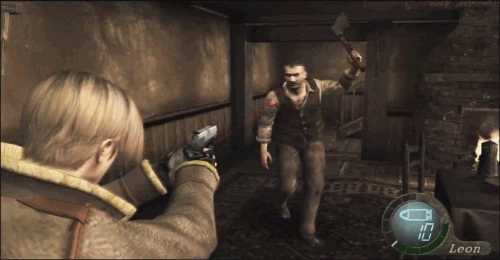
After what series creator Shinji Mikami felt was a poor turnout for Resident Evil (2002) and fan and media criticism started to flow in about the series feeling stale, a bold new direction was chosen for the world of BioHazard. Gone were the days of fixed cameras and tense inventory management, instead replaced by one of gaming’s most revolutionary innovations, what Capcom called the ‘Hit Zone Aiming System’. With the camera now locked behind Leon’s back and peering over his shoulder, we now controlled exactly where we shot (rather than having a vague “up/center/down” system). This resulted in a completely new take on combat that saw every area we shot the oncoming enemies (dubbed Ganado, which is Spanish for “livestock”) would cause a unique reaction. Shooting a weapon-brandishing hand would knock the blade from their grip, a pop in the shin would cause them to stumble to one knee, shooting them in the face would blind them, etc..
While this might sound more pedestrian now, back in 2005 there was nothing like it, and it turned the world of Resident Evil on its head.
Fuck ’em up
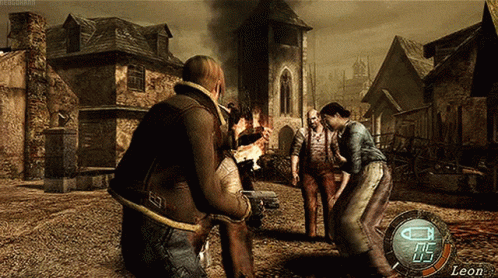
Remember how I talked about preparing for a fight, managing inventory carefully, and avoiding combat wherever possible for the other games? Yeah, nah, that’s all done here. Leon is a combat master now after serving years in the United States special forces and can take on pretty much anything Los Illuminados (“The Illuminated”) has to throw at him. Utilize the aforementioned hit-zone aiming to open up button-prompted melee attacks, slash at downed foes with a new knife that’s bound to your console of choice’s left bumper button rather than taking up space in your inventory, and keep an eye out for red oil drums (like in Resident Evil 3: Nemesis) to turn the murderous hordes into flaming debris. Make sure to keep an eye on felled enemies as well, as they can occasionally drop items — a blue (money), green (health), white (key items), or red (ammo) pillar of light indicates that that particular Ganado had something special in their pocket, just for you!
Along with this, new ways of finding ammo and items pepper the world in the form of wooden boxes and barrels, which can be destroyed with any of your weapons (I recommend using the ammo-free knife) to uncover a usually random assortment of all of the above to aid you in your destructive power! Just straight fuck ’em up, fam.
Tetris
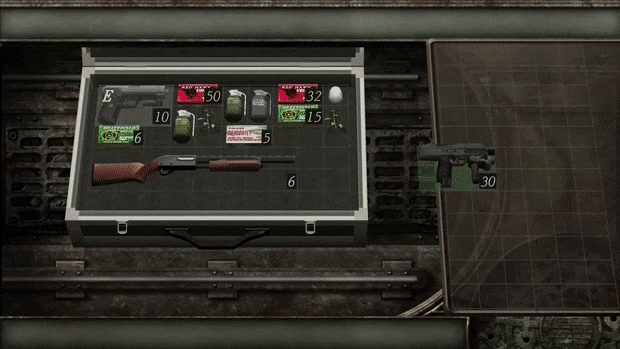
Another massive addition to Resident Evil 4 is the Attache Case, which replaces the original trilogy’s restrictive inventory slots. This time around, we instead have a large case made up of item “blocks”, and you have to find a way to fit everything depending on the item’s actual size, rather than each item just taking up a single slot. When you could comfortably fit a pistol and a shotgun together in your inventory in Leon’s previous outing, you now may find yourself instantly cramped trying to shove items together in this more realistic item space, turning and moving items to try and find the best fit. Your attache case can also be upgraded as the game progresses, but even that has its limits.
Prepare to get hurt
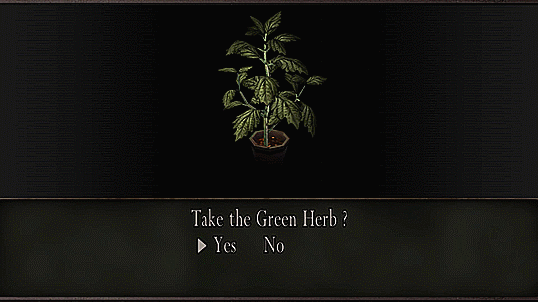
Eschewing the previous titles’ vague EKG health tracker, Resident Evil 4 instead opts for a simple health bar, which tallies your damage in segmented pips. Enemies can chip off varying amounts of health, from only a small sample to a massive chunk in a single blow. As such it’s imperative to be prepared as best you can, as being attacked comes just as fast as attacking in this game.
Like every other RE game, the primary method of healing is Herbs, which come in a variety of colors that grant different effects.
Green – Heals about 25% of your health, good for both bumping yourself up from a heavy attack, as well as giving you at least a little breathing room when your health bar begins to flash red. These can be combined with another green herb for a 50% heal, and a third for a 100% heal.
Red – Does nothing on its own (a standard for this item) but can be combined with a single green herb for a 100% heal effect.
Yellow – Essentially an entirely new item (a yellow herb existed in Resident Evil: Gaiden but it was a more standard health pickup), yellow herbs don’t actually heal you. Instead, they’re used to upgrade your maximum health, increasing your beefiness a little bit at a time. While they do require you to combine them with a green herb or a red/green mix, these are an invaluable part of your adventure.
Fish – Resident Evil 4 was the first game in the series to introduce consumables, one of which is… fish! Fish come in two varieties, small and large, with the former acting in place of a single green herb, and the latter as a full heal. These aquatic meals do come with a drawback, however. Unlike herbs, which take up a maximum of two blocks in your inventory apiece, fish take up between 3 (small) and 6 (large) blocks apiece. This can result in not having enough room for other valuable supplies, so think before you fish!
Eggs – Along with fish, Leon can also grab eggs from around Los Pueblos (“The Village”). These eggs come in three varieties — white (green herb), brown (x2 green herb mix), and gold (full heal). Eggs are fairly rare, and can only be harvested from either panicked or killed chickens (although the output is completely random) or killed snakes. A huge benefit to them is that they’re the smallest inventory item in the game, and only take up a single block of inventory space apiece. They can also be equipped and thrown at enemies for… some reason.
First Aid Spray – an item almost as ubiquitous with the series as the herbs, which will instantly heal you 100% on use. That said, it is extremely rare to find, and you should try to limit its use to when you absolutely need it.
Tactical Vest – This scrapped concept from Resident Evil 1.5 finally gets its chance to shine as an entirely new item. The Tactical Vest can be equipped after a certain point in the story and decreases all damage taken by 30% when worn. It also gives Leon a third look in the main campaign, which is pretty slick.
The Merchant
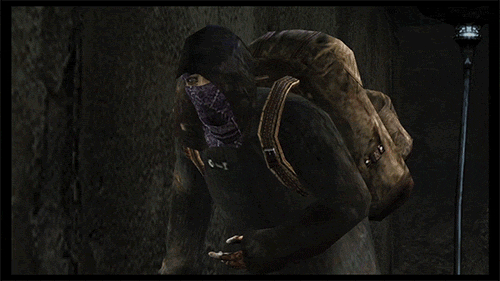
Another massive change to the formula is the inclusion of one of gaming’s most beloved characters, the Merchant. Enigmatic and jovial, this mysterious man has set up shop in Los Pueblos to give Leon access to an army’s arsenal, given he’s got the cash. Throughout your adventure, you’ll come across money (PTAS, or Pesetas) and treasures you can sell to the merchant in order to buff up your wallet to make game-defining purchases. From his ever-expanding shop, you can find a treasure trove of invaluable weapons that can only be found through him, upgrades for both your attache case and individual weapons, and even add-ons that increase accuracy and other features of your weaponry. The dude’s a godsend half the time, and he’s more than happy to trade goods and services for your objectively ill-gotten treasures. Fun fact: he’s voiced by Paul Mercier, who also does the voice for Leon!
Ashley
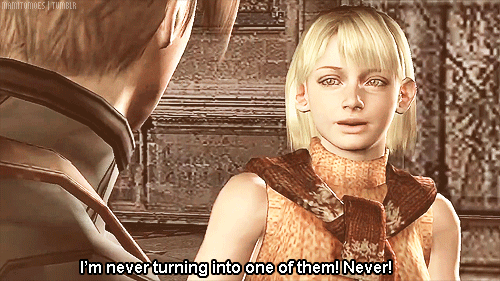
All of this carnage isn’t for the sake of it, of course. Leon’s real goal here is rescuing the one and only Ashley Graham, daughter of the President of the United States, from Los Illuminado’s clutches. As such, Ashley will occasionally partner up with you, for better or for worse. While Ashley is mocked by fans for her shrill voice in dangerous situations, keeping her by your side rather than telling her to stay put is the better option most of the time. Sandwiching her between your back and a wall works every time, and keeping her safe is the main priority in these instances. Ashley can also help on occasion, moving heavy boxes with you and pressing buttons while you focus on taking out enemies. If things get really dire there are a few instances where you can tell her to hide inside large trash containers. She really isn’t all that big of a problem, as long as you play it carefully.
Secrets and Bonus Content
Resident Evil 4 marked a major turning point for the series in terms of bonus content, in that it took some of the smaller concepts from previous games (like Resident Evil 2‘s The Fourth Survivor) and blew them up into massive, nearly campaign-sized adventures. A ton of other bonuses awaited the truly determined players as well, seeking a way to really conquer Resident Evil 4 to the absolute fullest.
Bonus Modes
The Mercenaries
Following up on the Resident Evil 3: Nemesis version, this version of The Mercenaries features four maps, three of which are from the main story mode and another that’s exclusive to this mode. Fighting against a never-ending onslaught of Ganado and racking up points while a timer counts down, it’s a race against time to master this challenging spin on the game’s combat. With three story-mode characters (Leon, Ada, and Krauser) as well as two bonus guest characters (HUNK and Albert Wesker), each character has their own specific loadout, melee moves, and health bars that really mix up your strategies for each encounter. This is personally one of my favorite takes on The Mercenaries, and it’s made all that more fun as you try to earn a five-star rating on each map with each character, as a special prize awaits for that kind of champion…
The Mercenaries VR
Exclusive to the Quest 2 version of Resident Evil 4, this take on The Mercenaries offers up an entirely new set of bonus rule-modifying modes! While it does feature all five characters and four maps, it also features about 30 new mini-modes that force strange, silly, and intense rules modifiers. From a mode that forces you to play as a knife-only Krauser to one that sees you battling your way through the Waterworld map as HUNK (equipped with a spear gun and fish), there are tons of fun and silly things to enjoy here. These quests also allow you to unlock new content (including a few brand-new ones) for the main story, which is even more satisfying.
Assignment Ada
A short story chapter of dubious canon, we play as Ada Wong during the events of Leon’s quest to save Ashley. Operating under direct orders from Albert Wesker, Ada is tasked with acquiring five samples of Las Plagas from the early Island section of the game. With no timer, this is simply an uber-challenging combat run from point A to point B as we try to complete our assignment and get out alive. Short, but fun, Assignment Ada was a great bonus on GameCube before being made almost superfluous by…
Separate Ways
Unlike Assignment Ada, Separate Ways is a three-hour-long campaign that tells the story of Resident Evil 4 from Ada’s perspective, seeing her walk in and out of Leon’s adventure to complete her own mission under orders from Wesker. Offering invaluable insight on the puppet strings being pulled behind the scenes, a new weapon, tweaked and more challenging gameplay, and three new areas to fight through, Separate Ways is the cherry on top of the full package. It’s worth noting that this mode was not available in the GameCube version.
Ada’s Report
This five-chapter diary of sorts showcases Ada’s thoughts on each major player in Resident Evil 4‘s storyline, from Leon to Wesker, and lifts the lid on much of the lore that was going on in the series at the time. Each cutscene is fairly short, featuring pre-existing in-game footage with Ada’s monologue over top, it’s a fun peek into her mind and a neat sequel to the DVD offering Wesker’s Report from years earlier. It’s worth noting that this content was not available in the GameCube version.
Cutscene viewer
It’s exactly what you think it is. A neat way of seeing a few of the game’s more QTE-heavy moments sans prompts. It’s worth noting that this content was not available in the GameCube version.
Professional Difficulty
This is the game at its hardest. Up for the challenge?
Unlockables Weapons
Infinite Rocket Launcher – Resident Evil‘s classic unlockable weapon, this is the game’s RPG-7 rocket launcher that can be purchased or found during the main game, but suped-up with infinite rockets. You gain access to this weapon upon completing the game once, however, it’ll cost ya — a staggering 1,000,000 PTAS from the Merchant’s shop. Once you manage to cash out on it though, this devastating weapon will kill pretty much every enemy in the game in just one shot.
Matilda – This weapon, a throwback to Leon’s upgraded VP70 from Resident Evil 2, is a three-burst rapid-fire pistol. While it can chew through enemies like butter, it also blows through ammo much faster than you’d expect it to. Just like the infinite rocket launcher, this’ll cost ya, requiring you to drop a cool 70,000 PTAS in the Merchant’s shop. It can be upgraded to hold a 100-round clip though, so that’s pretty neat.
Chicago Typewriter – After beating the game on either Professional Difficulty (GameCube) or completing Separate Ways (all other versions), this Thompson SMG is a classic among film noir enthusiasts and will rip through a crowd with its infinite ammo. Like the infinite rocket launcher, this’ll set you back 1,000,000 PTAS.
Hand Cannon – This impossibly powerful magnum revolver is one of the most powerful guns in the game, killing most enemies in a single hit, and can be upgraded to kill almost every enemy in a single hit with infinite ammo. Requiring its own special ammo type and featuring one of the game’s most satisfying reload animations, this beast can only be unlocked by completing all stages with all characters with a five-star ranking in The Mercenaries.
P.R.L. (Plaga Removal Laser) 412 – This sci-fi space laser gun thing is the game’s ultimate weapon, literally capable of killing every single enemy in the game in not only just one shot, but it’ll also wipe out the entire visible area in one charged shot. You can also simply press the fire button without charging to omit a quick burst of light that’ll act as a flash grenade, blinding and stunning an enemy. This is your reward for beating the game on Professional Difficulty, and by god you’ve earned it — take it free from the Merchant’s store, it’s yours.
Golden Weapons – Exclusive to Resident Evil 4 VR, these are just skins for your weapons that give them a more flashy look. Unlocked by completing challenges in The Mercenaries mode modifiers, they’re fancy and pretty, with new detailing that, while they offer no tactical advantage, are a sign of a true marksman.
VR Modes
Resident Evil 4 VR introduced a handful of exclusive new modes that don’t exist anywhere else, so it’s worth talking about them too.
Big Head Mode – Straight out of a classic PS2 game, Big Head Mode is exactly what it sounds like. Everyone (with the exception of Leon) gets comical bobble-head style craniums. It’s goofy and fun.
Fast Forward Mode – You move faster, but so do all of your enemies. They also now all talk in hilariously high-pitched voices, and it’s really hard not to burst out laughing hearing it. Note: this might be a little rough on you if you’re sensitive to motion sickness. I rarely get motion sick, and even I was starting to feel a little funky playing it.
Classic Horror Mode – Again, it’s exactly what it sounds like. Returning from Resident Evil 5 and Revelations 2, Classic Horror Mode drapes the entire game’s look in a black-and-white filter, complete with optional film grain. It’s neat and makes some of the darker sections of the game a smidge more terrifying. I don’t recommend playing with the optional “film grain” on though, the white spots that appear randomly are a bit disorienting, and feel oddly similar to “seeing stars” after getting hit in the head.
Unlockable Costumes
Costumes are a staple of this franchise, and for the first time, Resident Evil decided to play nice and just offer the costumes at the start of each playthrough rather than requiring some complicated junk that saw you missing out on the costumes for the first half of the game.
Costume 1
Leon – Jump into a little nostalgia with Leon’s classic look, updated. This is Leon’s R.P.D. riot uniform from Resident Evil 2, albeit with a few tweaks, changing the bright blue to a more deep navy (almost black) and affixing his new Chris-inspired knife sheath to his chest.
Ashley – It’s officially called the ‘pop-star’ costume but it ends up kinda looking like a low-key cowgirl stripper costume. Idk make of it what you will. This was deemed okay by Resident Evil 4 VR‘s censors, so I guess it must not be that sexy looking.
Ada – Oddly, she doesn’t wear her classic RE2 dress here, despite it existing in the game (it’s what she wears in The Mercenaries), instead slipping into a more practical, tactical look. With a black jumpsuit and vest, this is the same costume Ada wears in Assignment Ada, and is actually the same costume used for both costume selections.
Costume 2
Leon – A vintage, mafia-inspired look, complete with trilby and scarf. This look also grants you two special (and very goofy) animations when you try to reload the Chicago Typewriter, and changes Leon’s combat knife to a switchblade.
Ashley – if you’ve ever gotten frustrated with enemies killing her, grabbing her, or even your own attacks killing her? Look no further than this full suit of medieval armor, which keeps her completely protected from basically everything that could possibly happen to her during the game. She’s too heavy for enemies to pick up, impervious to both their attacks and yours, and even plays out a special animation when Leon tries to catch her full metal ass.
It should be noted that these costumes don’t appear in cutscenes in all versions of the game on console, but they do appear in cutscenes in Resident Evil 4 VR.
Secrets
Ditman – After a certain point during the game, you have a chance to purchase the Striker shotgun. After purchasing the shotgun, equip it from your inventory screen. Once in normal gameplay, hold down your platform’s aim button to ready the shotgun, but hit the inventory button as soon as possible, before the laser sight is on screen. Afterward, switch to any other weapon in your inventory and have a blast with super speed! Correctly performing this glitch causes all of Leon’s actions to be sped up, from running and climbing to firing and reloading. Things like hopping over obstacles and being hit by enemy attacks can end the glitch, but it’s easy enough to re-perform whenever. This glitch can also be used to break free from the map in a few places, where you might be surprised to find some hidden goodies in the void beyond…
Bonus treasure – in the game’s opening village area, where you first meet Dr. Salvador (the chainsaw Ganado), rather than holing up in the house where you find the shotgun, try to run ahead towards the farm area where you find your first Blue Medalion. The doorway to that area is blocked for now, but you’ll encounter a bonus Dr. Salvador! On first-time playthroughs, this might not be advisable, but on return trips with a stronger arsenal, blow him away and pick up the Ruby treasure he leaves behind — and then run into the shotgun house to spawn a second Salvador in order to get his treasure too!
Bing bong – while you’re standing in front of the church during the daytime segment of the game, take potshots at the bell in order to spawn more Ganado. Idk it’s fun.
Krauser Fight – Follow Leon’s example and try using knives during the boss fight with Leon’s old partner, Jack Krauser. The knife is really powerful against Krauser and can ace the fight without spending a single bullet.
Suit Up – When you go to play some Mercenaries, why not try holding down a different button, say Y/Triangle when selecting Leon or Ada? Never know what could happen…
Jetski style – during the game’s last escape sequence, where you and Ashley blast through a tight corridor aboard a jetski with water chasing close behind, tap your platform’s L+R buttons at the same time just as you hit a jump to try spinning because it’s a good trick.
And that’s a wrap! Now we have but to look out onto the brave new horizon of Resident Evil 4 Remake, due out in just a few weeks on March 24th!


